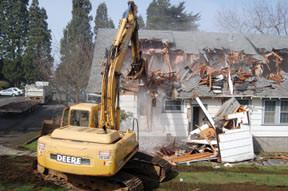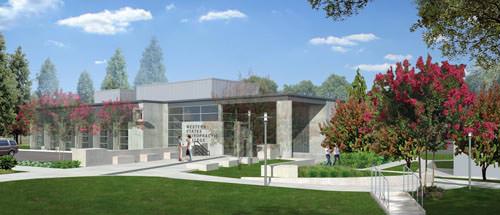 |
||||||||
| MEMO BLOG | Memo Calendar | Memo Pad | Business Memos | Loaves & Fishes | Letters | Home | ||
HEATHER HILL
THE MID-COUNTY MEMO
 |
| At Western States Chiropractic College last month the demolition of the old farmhouse (the so-called “White House”) signals the beginning of many changes at the 105-year-old institution. |
 |
| In five years as president of Western States Chiropractic College, Dr. Joseph Brimhall, has seen a 20 percent rise in enrollment. |
Located on an airy 22-acre campus tucked between I-84 and a web of residential streets in the east Portland Russell neighborhood, WSCC has educated generations in the “no-longer-so-alternative” medical practice for the past 36 years.
The third location in its 105-year history, WSCC moved to the 2900 N.E. 132nd Ave. address (formerly the Catholic girls’ school Marycrest) in 1973, where it has since existed in symbiosis with the neighboring community.
The second oldest chiropractic college in the country and the first to establish a four-year course of study on the subject, WSCC sports a history of conciliatory adaptation. From the 1930s to the 1950s, WSCC also offered a naturopathic degree. In a mid-century shift of purpose, the board decided to annex that program to create the separate National College of Naturopathic Medicine. Subsequently, WSCC charted its own course to complement traditional treatment methods.
“We don’t let grass grow underneath our feet,” WSCC President Dr. Joseph Brimhall said, regarding both past and future changes. “We’re not about maintaining the status quo. We want to make a difference.”
The first chiropractic college to require two years of preprofessional requirements to enroll, most of WSCC’s 455 students entered with a bachelor’s degree or a near equivalent number of credits in tow. While the college does offer Bachelor of Science completion courses and traditional medical science classes in anatomy, physiology, biochemistry, microbiology, pathology and nutrition, most of the college’s students come to study the deft techniques of the chiropractic discipline. These include spinal neuromusculoskeletal evaluation, biomechanics and adjusting, soft tissue examination and manipulation, among others. In addition, the college prepares its future physicians with the interpersonal foundations of diagnostic skills, including the ability to recognize and refer ailments outside the parameters of chiropractic care. It also features chiropractic radiology courses as a postdoctorate program.
WSCC established itself as an institution for both accruing and distributing information by conducting research. The first chiropractic college to receive a federal research grant through the Health Resources and Services Administration (a division of the U.S. Department of Health and Human Services), WSCC now executes studies examining chiropractic effectiveness on low back and neck pain as well as headaches. It has recently entered the second phase of a study on research literacy and evidence-based care, which Brimhall translated as “studying ways we can teach our students to better integrate research findings into practice in order to be more up on the current research.”
Studying the research not only helps the school balance its curriculum on the ever-accelerating forefront of science and technology, but it also steers administrators to identify ways to maximize their students’ potential.
“We see that the public is looking more and more to types of health care that are conservative, safe and effective,” Brimhall said. “Drug-based health care offers so much, but it has its limits. We feel there are many more avenues that we can help fill in.”
Seeking to incorporate a greater range of evidence-based care, WSCC instated a massage therapy program three years ago. While still small — consisting of approximately 20 students led by eight part-time faculty and one full-time administrator — the program has grown slowly and evenly, trusting its academic advantages to recommend it. “We are the only massage program in the region where our students have direct access to human cadaver dissection,” Brimhall said, an edge in a field many view as a spa science.
In order to instate master’s programs in other related fields, WSCC will make its most ambitious adjustment to date. “Because we already offer a doctorate and bachelor’s degree and now a master’s, we are going to change our structure to a university structure. Because we’re not going to focus exclusively on chiropractic, we’re going to change it into a health sciences university so we may encompass some of the programs. We’ll keep Western States Chiropractic College inside the university structure (for) our flagship programs, and then we will add other programs to be complementary to what we do.”
This fall, the school plans to unveil an Exercise and Rehab Science master’s program (aka: sports medicine). Though it cannot recruit students until completing accreditation, Todd Loggan, director of communications for WSCC, pointed out that due to popular demand, current students will most likely comprise the majority of the first year’s classes. The college already hosts a chiropractic sports medicine club as an extension of its sports medicine electives, in which club members ply their trade at area sporting events. By utilizing existing facilities and faculty and offering an online distance education option, the new department should require minimal additional financing. In fact, the school estimates that the program’s tuition should pay for itself without requiring a large initial investment for the upstart.
Other changes on the docket include upgrading and relocating existing facilities. The college plans to demolish two buildings: the old anatomy lab and the original farmhouse of the site, structures that have outlasted their usefulness, as is evident in the peeling siding and tilting architecture. The demolition of the old farmhouse will make room for the new anatomy lab.
Of the lab’s proposed design, Loggan said, “It’s cool. The new anatomy lab is going to be state of the art, 52-inch plasma screens with elevator cameras so that the anatomist can actually show the students up close and personal what is going on with the cadavers.” As a concession to the community, the new building will maintain the campus’s low profile in order to preserve the view.
Another impending modification involves the school moving its current on-campus clinic off school grounds. WSCC fourth-year students currently intern at three community clinics:
The Columbia Integrated Care Clinic, 5847 N.E. 122nd Ave. (Northeast 122nd Avenue and Airport Way), operates similar to most public health clinics but concentrates on chiropractic care, massage therapy, acupuncture and naturopathic medicine.
The West Burnside Chiropractic Clinic, 2221 W. Burnside St., offers free care to the uninsured and underinsured in cooperation with the Coalition of Community Health Clinics, a group of twelve nonprofit clinics in Multnomah County.
The Campus Outpatient Clinic, 2900 N.E. 132nd Ave., is slated to move to a still-debated site off campus and features chiropractic services and treatment, radiology, a laboratory, a variety of physiotherapy modalities, licensed massage therapy and rehabilitation. Potential sites in Gresham and Hollywood remain under review. Both satisfy the distance stipulation in keeping 15 miles from campus to accommodate students still attending classes. The Student Health Center, where students receive care from supervised third-year students, will move into the 8,800-square-foot campus clinic once the transition takes place, with the old farmhouse offices transferred to the former Student Health Center spaces.
Loggan assured that all plans seek to expand the school’s reach without forsaking its commitments. The presence of a public clinic on campus may come as a surprise to some, as the neighborhood association prohibited the college from advertising its on-site services in order to curtail outlying traffic. This will be a non-issue after the move. Once the clinic moves off campus, Loggan will be able to advertise the clinic to the public and they will reach more patients. However, WSCC does have plans to continue serving the public on site. Potential alternate uses for the new anatomy lab’s technology are under discussion, including summer camp possibilities.
In Brimhall’s five years as president, the college has seen a 20 percent increase in enrollment. University status may eventually usher in master’s degree programs in courses such as nutrition and diagnostic imaging, but the school has an incentive to introduce each with the same measured approach.
WSCC attracts students seeking a small, evidence-based institution with research facilities and courses specializing in their chosen field, and for this reason the school need not abandon its values in order to grow. “We are not looking to create a very large growth, just to better utilize our facilities and space so we are more cost efficient,” Brimhall said. “We’re going back to our roots of expanding and becoming more than just a chiropractic institution, so that is the primary vision change that has occurred. We are very committed to staying in Portland. We have been here for 105 years and we would like to continue to be a contributor to the community.”
 |
| Looking from the northwest view, the low-profile design for the new anatomy lab features state-of-the-art technology inside while preserving the surrounding landscape outside. |
| Submitted Photos |
 |
 |
 |
 |
MEMO Advertising | MEMO Archives | MEMO Web Neighbors | MEMO Staff | Home